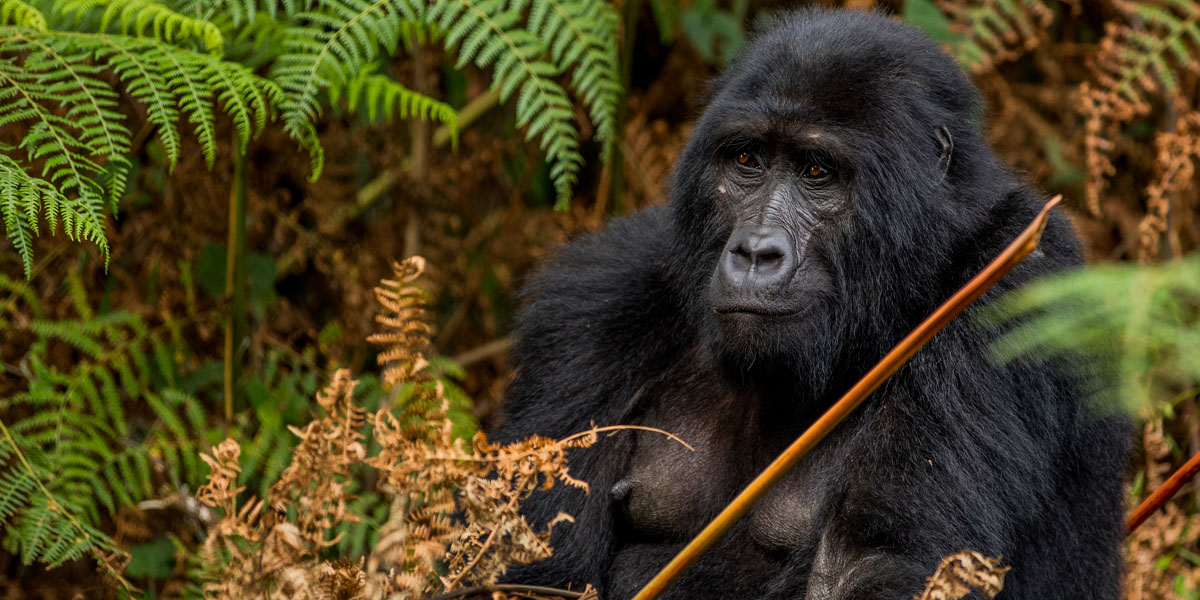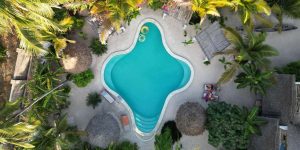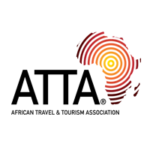Bwindi Impenetrable Forest is the most visited Uganda primate trekking safari destination. It is located in Southwestern Uganda stretching from Kanungu to Kisoro District. Bwindi Impenetrable Forest is among Africa’s best preserved Afromontane lowland forests and ecosystems.
It lies along the eastern edge of the Albertine Rift Valley, covering a land area of 321 square kilometers. Bwindi is home to mountain gorillas and several other wildlife species. The forest, Sarambwe Reserve, and the Virunga Massif are the only ecosystems with rare and endangered mountain gorillas.
Mountain gorillas are primates of the apes family. Mountain gorillas, Crossriver gorillas, eastern lowland gorillas, and western lowland gorillas are the 4 gorilla subspecies. These live in East and Central African forests but are among the most endangered wildlife species. Gorillas are threatened by habitat loss due to increased human population, poaching, and diseases. They have over 95% DNA similar to humans making them among man’s closest primates. This however makes them vulnerable to human illnesses including flu.
Bwindi Impenetrable Forest currently has the highest Mountain gorilla population. Below is what you need to know about this home of gentle giant apes.
Facts About Bwindi Impenetrable Forest
It is home to over 450 mountain gorillas. The total mountain gorilla population in the wild is estimated at 1100 individuals. Bwindi Impenetrable Forest has almost half of that number distributed in the different sectors of the forested park.
It is a UNESCO World Heritage Site. Bwindi Impenetrable Forest was inscribed as a World Heritage Site in 1994. This is because of the parks’ diversity and sanctuary to mountain gorillas. It is home to over 160 tree species, 100 ferns, 200 butterfly species, and over 350 bird species. Other notable wildlife species in Bwindi include chimpanzees, forest elephants, and l’hoest monkeys.
Bwindi Impenetrable Forest dates back over 25,000 years. The forest has been a wildlife sanctuary and water catchment area for years. It was gazetted as a national park in 1991 to ensure its continued preservation and sustainability.
Bwindi Impenetrable Forest Sectors
Buhoma, Ruhija, Nkuringo, and Rushaga are the sectors that comprise Bwindi Impenetrable National Park. Rushaga and Nkuringo are located in the southern part in the Kisoro District. Buhoma the first and oldest sector is located in the northern part of Bwindi.
Ruhija is located in the East, about an hour’s drive from Buhoma. Rushaga has seven habituated gorilla families. These include Bikingi, Kahungye, Nshongi, Bweza, Mishaya, Kutu, and Busingye.
Posho, Christmas, Nkuringo, and Bushaho are the four habituated gorilla families in the Nkuringo sector. Ruhija comprises Bitukura, Kyaguriro, Mukiiza and Oruzogo. The Buhoma sector has 6 gorilla families, including Mubare, Habinyanja, Rushegura, Muyambi, Katwe, and Binyindo.
There is still an ongoing gorilla habituation process aimed at making gorillas accustomed to human beings’ presence. We hope that the gorilla family numbers will increase with time.
The Mountain Gorilla Trekking Experience
Gorilla trekking starts with a briefing at the park headquarters of the different sectors of Bwindi. You are told about the gorilla trekking rules and regulations during the briefing. After the briefing you are led by the park ranger guides hiking through the forest for 1 to 6 hours. This depends on the movement of the mountain gorillas since they are mobile.
On getting to them, you keep at least a 10-meter distance. You can only stay up to an hour in their presence taking photos and learning more about them. After this remarkable encounter, you are led back to the park headquarters, where you are awarded your certificates of participation.
Best Time To Visit
Bwindi Impenetrable Forest can be visited any time of the year. For the best experience, we recommend visiting during the dry season from June to September and December to March. During the dry season, the forest trails are relatively dry and easy to navigate with minimal rainfall disturbances.
Rainfall is still unpredictable and can happen anytime, given the forest coverage and nature land. It is important to have rain gear just in case it rains.
Getting There
Bwindi can be accessed by road and air transport. It takes about a 9 to 10-hour drive from Kampala to the park when you drive directly. It can also be accessed from Kigali in a 4 to 5-hour drive. Bwindi can be accessed from other Uganda safari destinations like Lake Mburo, Queen Elizabeth, and Lake Bunyonyi. These take 3, 4, and 2-hour drives respectively depending on the sector you are visiting.
You can also start your Uganda tour to Bwindi from Kigali or connect to the park from Volcanoes National Park. Our 8-day Rwanda Uganda safari starts from Kigali and features a visit to Bwindi. There are daily scheduled flights from Bwindi to Masai Mara via Kisumu for immigration. This option works well for people interested in directly connecting to Kenya for classic African safari adventures.
Where to Stay
All the different sectors of Bwindi have a wide range of accommodation options from budget to high-end luxury lodges. Buhoma has the highest number of luxury lodges including Bwindi Lodge, Gorilla Forest Camp, Mahogany Springs, and Buhoma Lodge.
To avoid any inconvenience, it is advisable to book accommodation in the sector where you intend to track gorillas. We have customized several gorilla trekking packages to the different sectors of Bwindi. Notable ones include the 3-day gorilla habituation tour, the 4-day Uganda Wildlife tour, and the 5-day Uganda primates tour. These can be combined with a visit to Rwanda or our other featured safari destinations like Kenya, Burundi, Tanzania, and Eastern DRC.











